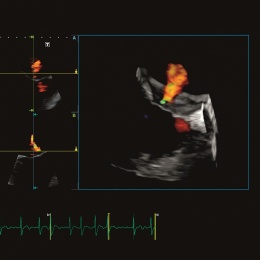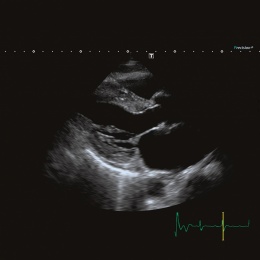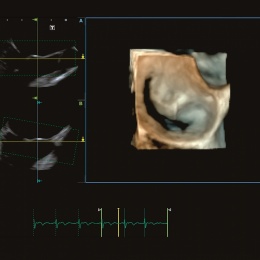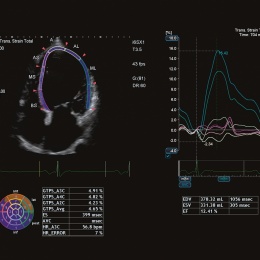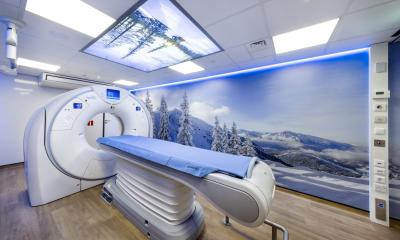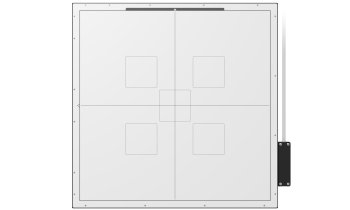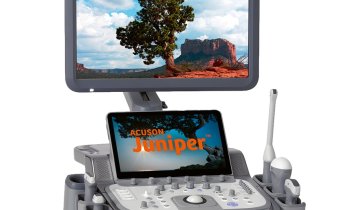Article • Echocardiography
Toshiba beams in on cardiology ultrasound
To sharply focus on the specialised requirements in echocardiography, Toshiba engineers built from scratch the Aplio i900CV with a total redesign of hardware and software. The new Aplio i-series is a premium addition to the award-winning Aplio 500 platform, which today is used in more than 31,000 clinical settings worldwide.
Report: John Brosky

‘The system works very fast with a reduced requirement for user interaction, which translates into a significant time saving for the echocardiography lab,’ according to the head of cardiovascular imaging at the Hospital Clinico San Carlos in Madrid, Spain, Professor Leopoldo Perez d’Isla MD.
The impressive speed of the new architecture and the resulting time savings, ‘means that we are improving the cost-effectiveness of the echo-lab, avoiding patient discomfort caused by unnecessary waiting times and increasing opportunities for patient examinations’.
The Aplio i-series jumps ahead to a next generation with an architecture that gives it on-board capabilities for ultra-fast processing of advance applications, and with a new range of high frequency and ultra-wideband transducers.
To maximise the potential of the new architecture, the Aplio i-series matrix transducers utilise a new lens material that effectively introduces a new technology. Thinner, lighter and with more flexible cables, a wide range of Aplio’s i-series transducers feature the Intelligent Dynamic Micro Slicing (iDMS) capability.
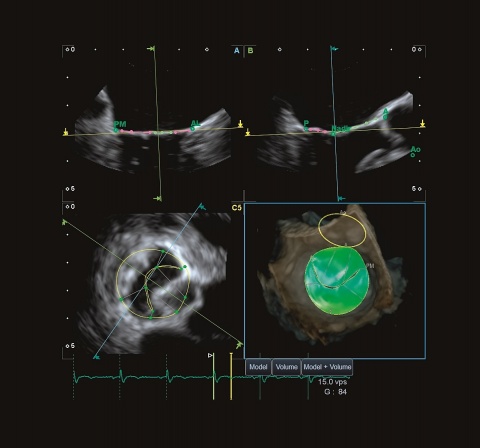
New with the Aplio i900CV is a 3-D transoesophageal echocardiography (TEE) transducer that ‘is exactly the tool we need,’ according to Professor Hans-Joachim Nesser MD. The Head of the Cardiology, Angiology, Medical Intensive Care for the 2nd Internal Department at the Elisabethinen Hospital in Linz, Austria, stated, ‘We have long wanted this, and here it is bringing the possibility to view aortic leaflets, or to measure mitral valve parameters where we can not only see the opening, but can even see the stitches where the valve has been repaired.’
Yet, thanks to the new ultra wideband transducers, a TEE exam is not always required. Nesser found that, with the wider coverage and what he called extremely good penetration up to 28 centimetres, ‘We can evaluate the aortic valve area with a transthoracic approach. We are able to see distinctly four-chamber views, and have found really fantastic resolution in subcostal views.’
Continuous wave Doppler on the i900CV has a quality not seen before that enables a fast, excellent quality of signal definition that allows an easy diagnosis to determine myocardial performance.
After working with Cardiovascular Imaging Fusion on the i900CV, Nesser concluded, ‘This is the future. In one display using a hybrid format we see calcified segments of coronary arteries derived from CT along with a quantification of the stenosis thanks to 3-D strain imaging, and at the same time a superimposition to the myocardium derived by CT. Using a very nice tool called Activation Imaging, we can add measurements to determine torsion, an important parameter for a variety of diseases, or see areas where there is delayed contraction. We can see rest and stress, related to a specific coronary artery as a superimposition on a CT image, enabling us to make a decision as to intervention.’
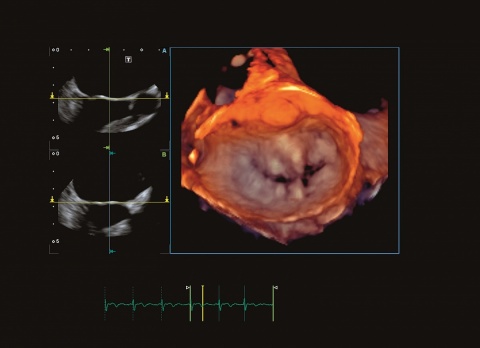
Aplio i-series processors are so fast that the system boots up in 15 seconds. Aplio i-series platforms are 30% lighter with a panel streamlined by a reduction of 50% for buttons and controls.
The panel arm supports a 23-inch high-definition display and is so flexible it can fold flat for easier, more convenient handling. And the Aplio i-series platforms come with an optional second console, a detachable wireless tablet that displays real-time images and can control all operations.
The Aplio i-series rolls out in three versions where the Aplio i700 is designed as a multi-service platform across diverse medical specialties, and the Aplio i800 responds to the more exacting requirements of radiology and women’s health departments.
Yet it is the advanced features and functionalities of the Aplio i900CV that are specifically designed to target specialised examinations and interventions in cardiology.
At the heart of an enhanced image quality that was described as ‘stunning’ by clinicians is the iBeam technology. Electrical dynamic focus with individual matrix element control and multiplexing with ultra-fast processing narrows and sharpens the signal for real-time 3-D beam forming.
The advanced architecture in the Aplio i-series takes pioneering Toshiba ultrasound functions to a new level.
- Advanced Superb Micro-Vascular Imaging (SMI) combined with the new transducers becomes more brilliant with reduced motion artefacts, for never-seen perfusion examination capabilities across all regions of human anatomy.
- Quad Fusion capability creates impactful viewing for interventional procedures or advanced diagnostics, with a simultaneous combination of CT/MRI images with real-time ultrasound and 3-D ultrasound rendering of a live procedure.
- Super precise 3-D imaging is boosted by Aplio i-series iBeam and thin slice acquisition to render near-photo quality images of anatomical structures.
Professor Adrian Lim MD, from Imperial College London said that, beyond the obvious improvements in ergonomics and speed with the Aplio i-series platform, for users of previous models of Toshiba ultrasound systems, ‘there is a very familiar workflow such that everything becomes intuitive the moment you step to the console.’
25.08.2016




